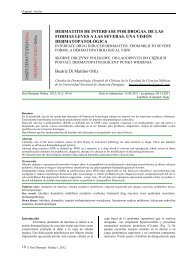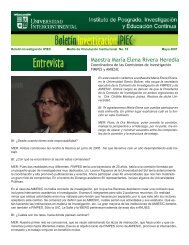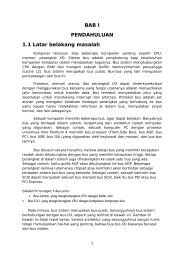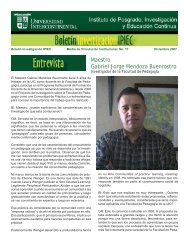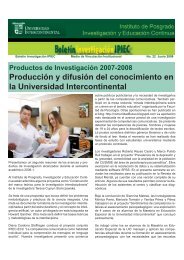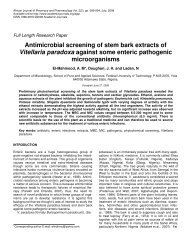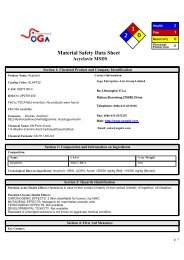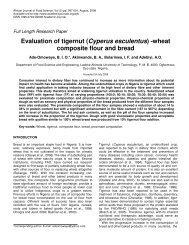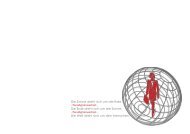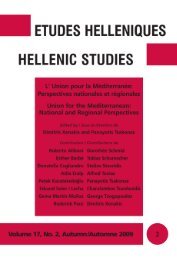Adsorption isotherm modeling of soy-melon ... - Science Stage
Adsorption isotherm modeling of soy-melon ... - Science Stage
Adsorption isotherm modeling of soy-melon ... - Science Stage
Create successful ePaper yourself
Turn your PDF publications into a flip-book with our unique Google optimized e-Paper software.
118 Afr. J. Food Sci.terials has been shown to be influenced by the temperature,relative humidity and moisture content and thus thewater activity (a w ) <strong>of</strong> the material (Iglesias and Chirife,1976). The relationship between water activity and moisturecontent <strong>of</strong> a food-stuff is important in predicting qualitystability during storage and the selection <strong>of</strong> appropriatepackaging materials for retail purposes (Igbeka,1982). The moisture levels at which some dehydratedfoods have good storage stability have been found toagree closely with the moisture levels calculated from thesorption <strong>isotherm</strong> at different ambient temperature andRH% (Igbeka and Nwachukwu, 1983; Mazza, 1986).Some studies have been carried out on the sorption <strong>isotherm</strong><strong>of</strong> Cassava products such as “gari” (Chuzel andZakhia, 1991), “lafun” (Onayemi and Oluwamukomi,1987), Instant cassava flour (Oluwamukomi, 1999), “fufu”(Sanni et al., 1997), “lafun” and Tapioca (Kuye and Sanni,2002).However there is dearth <strong>of</strong> information on sorption <strong>isotherm</strong><strong>of</strong> many African food products and specifically proteinenriched cassava products. A knowledge and understanding<strong>of</strong> such information on the optimum moisture levels,which should be arrived at during manufacture andfor selection <strong>of</strong> good packaging material is <strong>of</strong> great importancein order to avoid their quality deterioration duringstorage. The water sorption <strong>isotherm</strong> <strong>of</strong> foods is therefore<strong>of</strong> great importance. Many empirical relationships describingthe sorption characteristics <strong>of</strong> food such as Hasley(1948), Henderson (1952), Chung Pfost (1967), Oswin(1946), B.E.T (1938), Langmuir (1940), Smith (1947),Caurie (1970); and the three-parameter GAB model (Wolfet al., 1985; van de Berg, 1984). These models were chosenbecause <strong>of</strong> their suitability for high carbohydratefoods, application over a wide range <strong>of</strong> water activities,simplicity, and ease <strong>of</strong> evaluation (Ajisegiri et al., 2007;Oluwamukomi, 2008). GAB (Guggenheim-Anderson-DeBoer) model has been applied most successfully to describefood <strong>isotherm</strong>s up to a w <strong>of</strong> 0.9 (Van de Berg andBruin, 1981, Iglesias and Chirife, 1976; Labuza et al.,1985) and this has also been recommended by the EuropeanProject Group COST 90 on the Physical Properties<strong>of</strong> Foods as the fundamental equation for the characterization<strong>of</strong> water sorption <strong>of</strong> food materials (Wolf et al.,1985).The objective <strong>of</strong> this study therefore is to subject <strong>soy</strong><strong>melon</strong>protein enriched and un-enriched (control) “gari” tosorption <strong>isotherm</strong> study in order to determine if GABsorption model could be used to describe the sorption behavior<strong>of</strong> the two samples.MATERIALS AND METHODSSamples <strong>of</strong> <strong>soy</strong>-<strong>melon</strong> “gari” were produced according to the methods<strong>of</strong> Oluwamukomi (2006) and Banjoh Ikenebomeh (1996).The Cassava tubers were peeled manually with a sharp knife,washed and grated in a locally fabricated mechanical grater drivenby a powered system (7 hp) (Agunbiade, 2001). The cassava mashObtained was allowed to ferment for 72 h after which it was pressedin a mechanical press (Addis Engineering Nigeria Ltd., Nigeria) todewater the mash (Agunbiade, 2001; Adeyemi and Balogh, 1984,1985). The dewatered wet meal was pulverized and enriched withfull fat <strong>soy</strong>-<strong>melon</strong> supplement at 15% enrichment level and takinginto consideration the water content <strong>of</strong> the mash <strong>of</strong> 65% (Akingbalaet al., 1993). It was then toasted in a wide iron pan (garifier) beingheated over wood fire (Adeyemi and Balogh, 1984, 1985). Thetoasted and cooled <strong>soy</strong>-<strong>melon</strong> “gari” samples were then packagedin HDPE film and kept under refrigerated storage until ready for furtheranalysis.A static gravimetric method was used for the experiment (Greenspan,1977; Wolf et al., 1985). Duplicate samples, 3 ± 0.001 g each,<strong>of</strong> <strong>soy</strong>-<strong>melon</strong> and control “gari” were placed in Petri dishes inside 6desicators containing saturated salt solutions (KC 2H 3O 2, MCl 2,K 2CO 3, MNO 3, NaCl, KCl) providing constant relative humidity environmentsranging from 23 – 92% (Rockland, 1960; Labuza et al.,1985). The sample had been pre-dried in a desiccator with P 2O 5 atroom temperature for 15 days. At high relative humidity (a w > 0.7),toluene (1.5 ml) was placed in the desiccators to prevent microbialgrowth (Labuza, 1984; Kumar and Mishra, 2004). The desiccatorswere kept in temperature controlled cabinets at constant temperatures<strong>of</strong> 20, 30 and 40°C. The samples were weighed at intervals <strong>of</strong>3 days using a digital balance (Model Mettler PE1600, Mettler InstrumentsCorporation, Greifensee, Zurich, Switzerland) with an accuracy<strong>of</strong> 0.1 mg until constant weighs were obtained after threeconsecutives recordings, when the samples were assumed to be atequilibrium (± 0.001 g). The bone dry mass was determined by theoven-drying method for 8 – 10 h at 105 – 110°C (AOAC, 1990). Thetime to reach equilibrium ranged from 15 to 30 day depending onthe water activity in each desiccator with those at higher water activitiesreaching equilibrium faster than those at lower water activities.The equilibrium moisture contents were calculated from whichthe moisture sorption <strong>isotherm</strong>s were determined. The data for thewater adsorption were fitted to the GAB equation to describe theirmoisture adsorption using the GAB equation (Equation 1) (Van deBerg and Bruin, 1981).Theory <strong>of</strong> GAB equationThe GAB equation can be expressed as follows (Van de Berg,1984; Labuza et al., 1985):MeckMoaw=( 1−kaw)(1 − kaw+ ckaw)(1)The three parameters <strong>of</strong> GAB values <strong>of</strong> c, k and M o were derivedfrom the second order polynomial form (equation 2) which was solvedby multi-linear regression analysis to obtain , , , r 2 and RSS(Jouppila and Roos, 1997; Abramovi and Kl<strong>of</strong>utar, 2002; Xion,2002):a w= 2w wMeα a + βa+ γWhere; = k/M o(1/c – 1) = 1/ M o(1 - 2/c) = 1/ M okc(2)The values <strong>of</strong> parameters , , and were obtained for eachtemperature through the following relations:1M =(3)o( β 2 − 4αγ )



